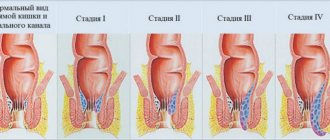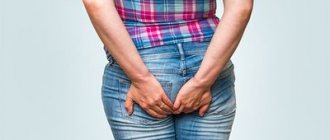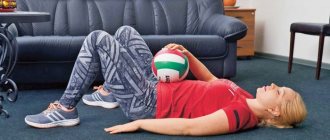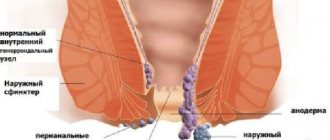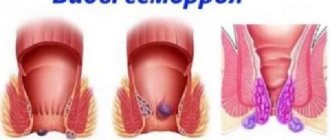Home » Hemorrhoids » External hemorrhoids: treatment
Sign up for a consultation with a proctologist for the treatment of hemorrhoids for 3,500 rubles and receive a treatment prescription within 30 minutes for 1 appointment
Find out what day you need to make an appointment to get a consultation without a queue.
Experience 44 years 73 operations per month 876 operations per year 171 reviews Author of 73 scientific papers Has 9 patents 6,818 requests per month
Call
A common proctological disease is called external hemorrhoids. The pathology is diagnosed in both young people and the elderly. Moreover, hemorrhoidal cones often appear in children. The disease is characterized by varicose veins in the anal area. Hemorrhoids form and rapidly increase in size. Upon palpation, neoplasms can be easily detected.
Every fourth patient suffers from external hemorrhoids. According to medical statistics, males are more prone to developing proctological disease. As a rule, most men work physically, and as a result, the functioning of the gastrointestinal tract is disrupted and anal fissures appear. Hemorrhoids progress quickly, so doctors advise starting treatment as early as possible to reduce the rehabilitation period.
Often external hemorrhoids develop in parallel with internal ones. We are talking about combined hemorrhoids, which is not so easy to cure. Lack of timely treatment leads to venous thrombosis and damage to the cavernous veins. Hemorrhoids are a multifactorial disease and are accompanied by obstructed outflow of venous blood in the hemorrhoidal plexuses.
How to cure external hemorrhoids? Specialists from the private proctology center “Proctologist 81” will answer this question for you. Doctors of the highest category will consult you at any convenient time, refer you to diagnostic tests of the body and prescribe effective treatment. With the help of modern equipment, the disease will be detected even in the early stages.
Symptoms of external hemorrhoids
External hemorrhoids are accompanied by a number of specific symptoms. That is why, when making a diagnosis, an experienced doctor can immediately identify this disease. In the early stages there are no symptoms. Starting from the second stage, the patient is bothered by such signs as:
| Bloody discharge in stool | After each act of defecation, the patient notices that blood clots have appeared in the stool. Also, a symptom of hemorrhoids can be impurities of pus and mucus in the stool. In the early stages, bleeding is drip-like. In advanced cases, stream bleeding occurs, which bothers the patient every day after each bowel movement. The blood has a bright scarlet hue. As a rule, bloody discharge appears on the stool, and not inside it. This symptom indicates mechanical damage to the veins. |
| Painful sensations during defecation | When emptying the intestines, the patient experiences cramping pain. They are associated with stagnation of feces in the body, which turns to stone. When a person strains to defecate, anal fissures form, which lead to hemorrhoids. The pain intensifies when coughing, when walking, when sneezing. In some cases, pain occurs during a sedentary lifestyle or physical work. Each patient's pain pattern is different. In the third and fourth stages, the pain does not disappear even after taking painkillers. The patient is forced to consult a proctologist. |
| Sensation of an otherworldly object in the anus | When moving, the patient begins to feel the presence of an otherworldly body in the anus. This occurs with enlarged hemorrhoids. |
| Itching and burning in the anus | With hemorrhoids, common symptoms include burning and itching in the anus. The discomfort intensifies when walking. |
| Nodules around the anus | The anal area is constantly damaged, the functioning of the sphincter is disrupted, and therefore nodular neoplasms are formed. The size of the nodes is on average two centimeters. If left untreated, the veins become clogged with blood clots. |
| Hardening and discoloration of hemorrhoids | As the disease progresses, hemorrhoids become denser and increase in size. They acquire a dark blue hue, which indicates swelling and inflammation. |
| Tissue necrosis | This symptom is also a complication of hemorrhoids. Hemorrhoids change color and become purple or black. Such a change is extremely dangerous for human health and life. |
| Lack of appetite | With hemorrhoids, intestinal dysfunction is observed. The patient has no appetite. Associated symptoms include vomiting, belching and nausea after eating. If the above symptoms appear, you should change your diet and eliminate foods that cause fermentation. |
| General weakness of the body | With proctological diseases, the patient feels general weakness and lack of energy. Blood pressure and body temperature decrease. Fever and chills begin. |
| Diarrhea and constipation | Impaired functioning of the gastrointestinal tract negatively affects intra-abdominal pressure. The patient's abdomen becomes bloated, colic and flatulence appear, which disrupts the usual way of life and brings discomfort. With diarrhea, the mucous membrane of the anus is irritated, anal fissures form, and soft tissues are irritated. Constipation is also dangerous to your health. Lead to stagnation of feces in the human body. |
Also, a person who suffers from hemorrhoids may experience dizziness, tinnitus, and lack of coordination.
Drug treatment
Medicines used for internal hemorrhoids:
- Detralex, Phlebodia, Vasoket
– tablets and suppositories from the group of venotonics, which increase the tone and elasticity of the venous walls, strengthening them. They contain horse chestnut extract.
- Anti-inflammatory suppositories and ointments
– relieve swelling and pain. May refer to NSAIDs (non-steroidal anti-inflammatory drugs), such as suppositories with indomethacin, as well as hormonal drugs (containing hydrocortisone).
- Troxevasin, Heparin
– drugs from the group of thrombolytics that prevent the formation of blood clots in hemorrhoids. Available in the form of ointments and rectal suppositories.
- Analgesics
– drugs that relieve pain, method of use, both oral (tablets) and local (suppositories with menthol and belladonna for local anesthesia).
- Antiseptics
– drugs for stopping infection in venous nodes affected by the pathological process (ichthyol ointment, microenemas with a decoction of chamomile and calendula).
- Preparations for the regeneration of venous walls
– used to speed up the healing process (suppositories with sea buckthorn oil, propolis, methyluracil).
- Drugs with a hemostatic effect
– used in the form of suppositories (Thrombin) and tablets (Vikasol).
Reasons for the development of hemorrhoids
There are many reasons that influence the development of proctological disease. Among them, it is worth paying attention to the fact that
- With increased physical activity, intra-abdominal pressure increases, cavernous veins are deformed and damaged, and the vessels become weak and thinned. The risk group includes construction workers, security guards and other people who work physically. Athletes and gymnasts are prone to developing hemorrhoids. Lifting weights also provokes the development of proctological diseases.
- With a passive lifestyle, hemorrhoids develop in most cases. Feces stagnate in the body, the vessels of the anus dilate. The work of the esophagus is disrupted and hampered, the patient constantly feels discomfort in the abdominal organs. The risk group includes office workers, drivers, and salespeople.
- People who are genetically prone to hemorrhoidal diseases have weakened internal organs from birth, the functioning of which is regularly disrupted. The vessels are thin, susceptible to inflammation. Venous blood overflows the veins, stagnates in the cavernous veins and leads to the formation of thrombosis.
- With soft tissue hyperplasia, hemorrhoids are diagnosed in most cases. We are talking about the dilation of blood vessels in the anal area. The veins become tortuous and damaged, and become injured. The blood stagnates, so intra-abdominal pressure increases. Collagen fibers weaken and form longitudinal muscles. The size of hemorrhoids increases.
- Constant disturbances in the functioning of the gastrointestinal tract have an extremely negative impact on the condition of the vessels in the anus. Bleeding begins and the mucous membrane becomes inflamed. The patient feels discomfort that does not disappear.
- If a person is diagnosed with a duodenal ulcer, chronic gastritis, duodenitis, proctitis, then hemorrhoids develop in parallel. The patient's condition deteriorates sharply.
- During pregnancy, the weight of the woman and the embryo constantly increases. There is strong pressure on the abdominal organs. Their functionality is impaired, anal fissures form, and the size of hemorrhoids increases. When pushing and laboring, the pregnant woman pushes hard, which affects the thinning of blood vessels and soft tissues.
- Infectious diseases and inflammatory processes provoke the development of proctological pathologies. The body as a whole weakens. An external lump of hemorrhoids appears.
- An unhealthy diet can cause hemorrhoids. Fatty and smoked foods, baked goods, sweets, salty and spicy foods have a negative impact on the condition of the intestines. The microflora is disrupted, the esophagus does not function as it should.
- Smoking and alcohol abuse negatively affect the condition of all internal organs, including the digestive tract. Inflammation of the walls of the rectum is observed.
How to treat external hemorrhoids in men
To treat external hemorrhoids in men, conservative treatment methods are used in most cases. Medications can relieve the patient from painful syndromes and complications. Medicines help normalize blood circulation, increase the firmness and elasticity of veins.
External hemorrhoids are removed in critical cases. We are talking about the third and fourth stages of proctological disease. Held:
- laser coagulation,
- latex ligation of hemorrhoids,
- sclerotherapy using special drugs that are injected into the anus.
Each patient is assigned individual treatment. The duration of rehabilitation and treatment depends on the patient’s condition and the size of the hemorrhoids.
A popular method of treating hemorrhoids in men is called cryodestruction. The affected area is treated with liquid nitrogen. Ultra-low temperatures allow you to painlessly remove hemorrhoids in a short time. The tumors die and fall out on their own after a few hours. The advantage of this therapy is that it is bloodless and effective. Relapses occur extremely rarely.
Exacerbation treatment regimen
Ice suppositories and cold compresses on the inflamed area are the most effective remedy in the first hours of exacerbation of external hemorrhoids. Vasospasm, which occurs when exposed to cold, pushes blood out of the hemorrhoids and serves as a prevention of venous thrombosis.
After pain and swelling are relieved, exposure to cold is replaced with sitz baths with warm water. This measure is aimed at destroying blood clots. An additional effect is obtained from the use of anticoagulant ointments. If the symptoms persist and the patient’s condition does not improve after the measures taken, medications are used for external and internal use.
A radical measure for complications of hemorrhoids is a surgical operation to excise the blood clot (thrombectomy).
How to treat external hemorrhoids in women
A woman has hemorrhoids, what should she do? First of all, you should consult a proctologist. The medical specialist will refer the patient for the necessary comprehensive studies. Most often, women undergo minimally invasive treatment methods that do not affect internal organs or violate the integrity of soft tissues.
Such treatment methods eliminate provoking factors and normalize stool. Herbal medicine, massages, and medical procedures on an outpatient basis are also used to prevent the development of hemorrhoids. If a woman is diagnosed with thrombosis of hemorrhoids, thickening of tumors and a rapid increase in size, then surgical intervention is advised. In most cases, sclerotherapy is performed. The patient is injected with a special substance that glues the walls of blood vessels and penetrates the lumen. The effect is on the affected veins.
An equally effective procedure is laser coagulation or hemorrhoidectomy. There is no bleeding, the risk of complications and relapses is reduced to zero. In addition, laser coagulation is carried out within thirty minutes, which significantly reduces the rehabilitation period. After the procedure, the patient can go home and return to her normal lifestyle.
Hemorrhoids are also treated using infrared coagulation. Infrared radiation is directed at the affected area, which prevents blood from entering the affected cavernous veins. As a result, hemorrhoids die and fall out of the anus. Treatment with conservative methods is possible. Known remedies for external hemorrhoids are Relief, Proctosedyl, Proctosan and other drugs that help stop the development of the disease.
Surgical methods
Radical treatment of internal hemorrhoids has many surgical techniques in its reserve. Most of them are minimally invasive technologies with virtually no complications.
These methods can be used to treat internal hemorrhoids up to stage 3 inclusive:
- Sclerotherapy
– during this procedure, a sclera-forming substance is injected into the hemorrhoid. As a result of its action, the walls of the venous node are glued and sealed, and it is subject to destruction.
- Ligation
– placing a latex ring on the vessels responsible for the blood supply to the hemorrhoid. The node dies within 7-8 days due to the fact that there is no blood flowing into it.
- Laser coagulation and photocoagulation
– a tip with a laser or light emitter is inserted into the rectum, and it precisely heats the hemorrhoidal node, the walls of which become sclerotic and the node ceases to exist.
- Cryotherapy
– exposure of the hemorrhoidal cone to liquid nitrogen, which has an extremely low temperature, causes the tissue of the node to die.
All these procedures use local anesthesia, they are not accompanied by blood loss, have no complications, do not require a long recovery period, and can be performed in a day hospital or on an outpatient basis. The effect of such manipulations immediately makes itself felt: the symptoms of the disease do not bother the patient, hemorrhoids cease to exist, and the patient experiences significant relief. However, the cause of hemorrhoids using these methods cannot be excluded; weakness of the vascular walls can lead to a relapse of the disease.
Advanced stages of internal hemorrhoids can be cured only by radical methods - hemorrhoidectomy (excision of nodes). In addition to removing hemorrhoidal cones, the surgeon sutures weak vein walls to strengthen them and prevent the possibility of recurrence. Due to the complexity and traumatic nature of such operations, they are performed under general anesthesia in a surgical department. The patient is hospitalized for a fairly long period of time, the recovery period after surgery takes from 2 to 4 weeks. Although both doctors and patients with advanced forms of hemorrhoids are reluctant to undergo such operations, in the medical practice of proctologists there are cases when this is the only acceptable method of getting rid of the disease.
